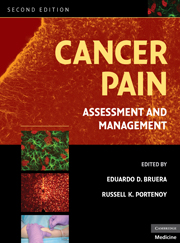Book contents
- Frontmatter
- Contents
- Contributors
- Preface
- SECTION I MECHANISMS AND EPIDEMIOLOGY
- SECTION II EPIDEMIOLOGY AND SYNDROMES
- SECTION III ASSESSMENT
- SECTION IV PHARMACOLOGICAL TREATMENT
- 9 Pharmacology of analgesia: basic principles
- 10 Pharmacogenetic considerations in the treatment of cancer pain
- 11 Pharmacology of opioid analgesia: clinical principles
- 12 Opioid side effects and management
- 13 Antipyretic analgesics
- 14 Adjuvant analgesic drugs
- 15 Neuraxial analgesia
- SECTION V OTHER INTERVENTIONAL STRATEGIES
- SECTION VI REHABILITATION AND PSYCHOLOGICAL INTERVENTIONS
- SECTION VII THE ROLE OF ANTINEOPLASTIC THERAPIES IN PAIN CONTROL
- SECTION VIII PAIN IN SPECIAL POPULATIONS
- SECTION IX DIFFICULT PAIN PROBLEMS
- SECTION X SYSTEMS OF CARE
- Index
- Plate section
- References
13 - Antipyretic analgesics
from SECTION IV - PHARMACOLOGICAL TREATMENT
Published online by Cambridge University Press: 06 July 2010
- Frontmatter
- Contents
- Contributors
- Preface
- SECTION I MECHANISMS AND EPIDEMIOLOGY
- SECTION II EPIDEMIOLOGY AND SYNDROMES
- SECTION III ASSESSMENT
- SECTION IV PHARMACOLOGICAL TREATMENT
- 9 Pharmacology of analgesia: basic principles
- 10 Pharmacogenetic considerations in the treatment of cancer pain
- 11 Pharmacology of opioid analgesia: clinical principles
- 12 Opioid side effects and management
- 13 Antipyretic analgesics
- 14 Adjuvant analgesic drugs
- 15 Neuraxial analgesia
- SECTION V OTHER INTERVENTIONAL STRATEGIES
- SECTION VI REHABILITATION AND PSYCHOLOGICAL INTERVENTIONS
- SECTION VII THE ROLE OF ANTINEOPLASTIC THERAPIES IN PAIN CONTROL
- SECTION VIII PAIN IN SPECIAL POPULATIONS
- SECTION IX DIFFICULT PAIN PROBLEMS
- SECTION X SYSTEMS OF CARE
- Index
- Plate section
- References
Summary
Introduction>
Antipyretic (or nonopioid) analgesics are a group of heterogenous substances including acidic (nonsteroidal anti-inflammatory drugs [NSAIDs]) and nonacidic (acetaminophen, pyrazolinones) drugs. Moreover, various selective cyclooxygenase-2 (COX-2) inhibitors with improved gastrointestinal tolerability compared with conventional NSAIDs have been established for symptomatic pain treatment in recent years. This chapter summarizes the pharmacology of all these drugs, with particular emphasis on their rational use based on their diverse pharmacokinetic characteristics and adverse drug reaction profiles. Moreover, the mechanisms underlying their antihyperalgesic action are extensively discussed.
Mode of action of antipyretic analgesics
Inhibition of cyclooxygenase enzymes
In 1971, Vane showed that the anti-inflammatory action of NSAIDs rests in their ability to inhibit the activity of the COX enzyme, which in turn results in a diminished synthesis of proinflammatory prostaglandins. This action is considered not the sole but a major factor of the mode of action of NSAIDs. The pathway leading to the generation of prostaglandins has been elucidated in detail. Within this process, the COX enzyme (also referred to as prostaglandin H synthase) catalyzes the first step of the synthesis of prostanoids by converting arachidonic acid into prostaglandin H2, which is the common substrate for specific prostaglandin synthases. The enzyme is bifunctional, with fatty-acid COX activity (catalyzing the conversion of arachidonic acid to prostaglandin G2) and prostaglandin hydroperoxidase activity (catalyzing the conversion of prostaglandin G2 to prostaglandin H2).
In the early 1990s, COX was demonstrated to exist as two distinct isoforms.
- Type
- Chapter
- Information
- Cancer PainAssessment and Management, pp. 255 - 271Publisher: Cambridge University PressPrint publication year: 2009



